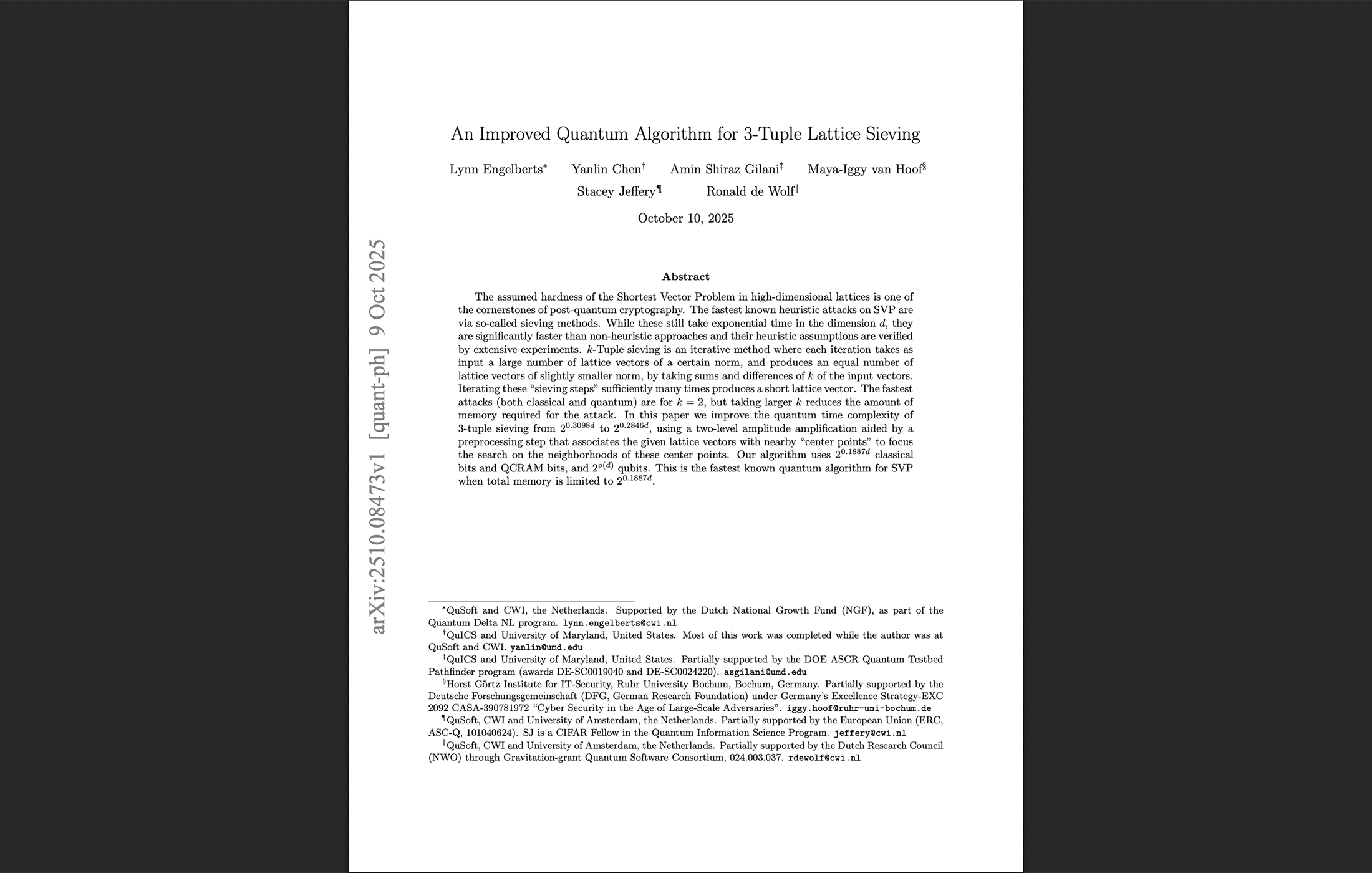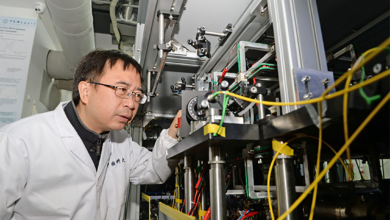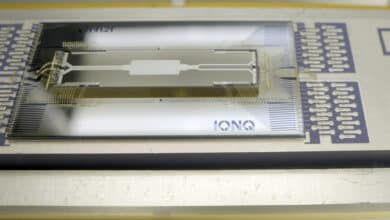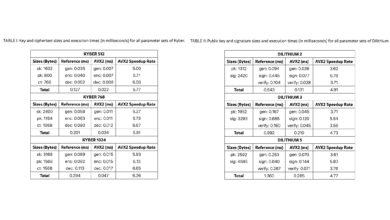Quantum Sieving Breakthrough: Lattice Attack Exponent Slashed by 8%

Table of Contents
10 Oct 2025 – A Dutch-led research team has achieved a significant breakthrough in quantum cryptanalysis of lattices. In an October 2025 paper “An Improved Quantum Algorithm for 3-Tuple Lattice Sieving” on arXiv, the authors report reducing the time complexity exponent for a key lattice attack from 0.3098 to 0.2846.
In practical terms, this ~8% drop in the exponent translates to a theoretical speedup on the order of tens of millions for large lattice dimensions. For example, at dimension d = 1000, the previous best heuristic quantum attack took roughly $$2^{0.3098 \cdot 1000}$$ steps, whereas the new method takes about $$2^{0.2846 \cdot 1000}$$ steps – a difference factor of approximately $$2^{25}$$ (around 33-60 million times faster).
Crucially, the attack still runs in exponential time (so it’s far from “efficient” in the usual sense), but it now marks the fastest known quantum approach to the Shortest Vector Problem (SVP) under stringent memory limits.
This advance targets the SVP, the hard mathematical problem underpinning most lattice-based post-quantum cryptography. SVP asks: given a high-dimensional lattice (think of a grid in d-dimensions), can you find the shortest non-zero vector in that lattice?
Modern encryption schemes like Kyber (a KEM/key encapsulation mechanism) and Dilithium (a digital signature scheme) owe their security to the assumed hardness of SVP in large dimensions. Until now, the best heuristic attacks for finding short vectors in a lattice have involved sieving algorithms, which cleverly trade massive memory usage for faster search time.
The new result comes from applying quantum computing techniques to a 3-tuple lattice sieving method, and it shaves the time exponent by about 8%, thereby accelerating the attack without using more memory. In fact, the algorithm uses about $$2^{0.1887d}$$ bits of memory (classical + quantum accessible) – a huge number in absolute terms, but slightly less (in exponent) than prior state-of-the-art attacks required. Under such tight memory constraints, this quantum 3-tuple sieve now outruns all previous SVP attacks; it even beats the best known classical sieve (exponent ≈0.2925) in speed.
Bottom line: a task that was already astronomically hard remains astronomically hard – but it just got noticeably less hard in the eyes of a quantum algorithm.
Why an 8% Drop in Exponent Matters
At first glance, trimming an exponent from 0.3098 to 0.2846 might sound like an esoteric optimization. However, in an exponential-time algorithm, small reductions in the exponent blow up to enormous speedups at scale. An 8% decrease in the exponent means that as the lattice dimension d grows large, the new attack runs in about $$2^{(0.3098-0.2846)d} = 2^{0.0252d}$$ times fewer steps than before.
For large d (several hundred to a thousand, relevant for cryptographic security levels), that factor is astronomical – on the order of millions or more. This is why researchers are excited: it’s a significant leap forward in quantum cryptanalysis of lattices, accomplished not by building a faster quantum computer, but by discovering a smarter algorithm.
To put it in perspective, consider that the best known classical (non-quantum) lattice sieve runs in about $$2^{0.292d}$$ time. The previous quantum algorithms (for k=2 sieving) brought that down to roughly $$2^{0.265d}$$ by using Grover-style quantum search. But those 2-sieve algorithms demand enormous memory – on the order of $$2^{0.205d}$$ space (for d=438, that’s about $$2^{90}$$ bits, vastly more memory than even a supercomputer has). In practice, such memory requirements are a limiting factor.
The new Dutch-led 3-sieve attack finds a sweet spot: its exponent 0.2846 is a bit higher than the absolute quantum minimum (0.265) but it slashes the memory needs to $$2^{0.1887d}$$ bits. In scenarios where memory is at a premium, this makes it the fastest known SVP attack. In fact, under those memory limits, it’s now the record-holder for SVP – even faster than the best classical algorithm (exponent ~0.292).
This demonstrates a key point for cybersecurity professionals: algorithmic advances can erode the safety margin of cryptographic assumptions, even before the hardware catches up. In other words, it’s not just about how many qubits a future quantum computer has; it’s also about how cleverly those qubits are used.
Now, what does this mean for lattice-based post-quantum schemes like Kyber and Dilithium? The good news is that this result doesn’t break those schemes. The attack still requires exponential time in the lattice dimension. Current parameters for Kyber, Dilithium, and other lattice-based standards are chosen such that all known attacks (even quantum ones) are computationally infeasible. The new algorithm, while dramatically faster in theory than its predecessors, would still need an unrealistically large quantum computer and an astronomical runtime to challenge the recommended parameters. So in practical terms, Kyber and Dilithium remain secure for now – there’s no immediate threat to deployed post-quantum cryptography.
However, this kind of research is a wake-up call. It reminds us that the trajectory of quantum attacks is trending in one direction: more efficient. Each improvement – even incremental – eats into the safety margin. If an 8% exponent reduction can yield a 50-million-fold speedup at d=1000, one shudders to think what a further reduction might do. Cryptographic parameter choices (like lattice dimension, modulus sizes, etc.) may need to be revisited over time if algorithmic progress continues. In standards committees and security analyses, experts will keep an eye on such breakthroughs to ensure “bug distance” – the gap between the best known attacks and the difficulty required to break a scheme – remains comfortably wide.
Under the Hood: Two-Level Quantum Search and Centered Filtering
How did the researchers achieve this speedup? The paper introduces two main innovations under the hood: (1) a two-level amplitude amplification search, and (2) a clever center-point filtering strategy. Together, these techniques allow the quantum algorithm to zero in on useful combinations of lattice vectors far more efficiently than before.
Two-Level Amplitude Amplification
Amplitude amplification is the quantum trick behind Grover’s algorithm – it lets a quantum computer amplify the probability of finding “good” solutions in an unstructured search space. In this SVP attack, the authors use nested (two-tier) amplitude amplification to hunt for helpful 3-tuples of lattice vectors. In simple terms, they set up an outer quantum loop that checks if a given triple of vectors reduces to something shorter (i.e. a potential progress toward the shortest vector), and an inner loop that generates random candidate triples in superposition. The outer loop amplifies the amplitude of those state(s) where the inner loop found a successful 3-vector combination.
By stacking two Grover-like searches back-to-back, the algorithm boosts the success probability faster than a single search would. This careful orchestration of quantum searches is a big part of shaving down that time exponent.
Center-Point Filtering
A core challenge in k-tuple sieving is that there are astronomically many ways to pick k vectors from a large list. Most combinations don’t lead to a shorter vector (they don’t “cancel out” enough). The new algorithm tackles this with a preprocessing step that assigns each lattice vector to one (or more) “center points” – essentially reference vectors that serve as cluster centers. Think of dropping a bunch of points (centers) on the unit sphere and grouping your lattice vectors by which center they’re closest to. Now, when searching for a good triple (x, y, z), the algorithm restricts attention to triples where, say, x and y are near the same center, and z is near a center associated with the direction of x−y. This focuses the search on promising neighborhoods in the space of vectors rather than trying all random triples. By filtering out unlikely combinations early (via these center-point groupings), the quantum search can spend its effort on a much smaller search space where success is more likely. The authors implemented this using structures called Random Product Codes to generate the centers, and they store associative data so that the quantum algorithm can query “which vectors are near center $$c$$?” in superposition.
The end result is a dramatically more targeted sieve: it’s as if finding a short vector becomes a needle-in-haystack problem with most of the hay removed.
Quantum Memory (QRAM) Role
To pull off the above tricks, the algorithm relies on a quantum-accessible memory for the list of lattice vectors. In the paper, they assume a model where a large table of vectors (on the order of $$2^{0.1887d}$$ entries) is stored in classical memory but can be queried by the quantum computer in superposition. This is often called QRAM (Quantum Random Access Memory). QRAM allows the quantum algorithm to, for example, check many vector-pair combinations in one big superposition, or find all vectors near a certain center, without iterating through the list classically one by one. It’s a powerful capability – but it comes with caveats. Building a true QRAM of that size is technologically very challenging; today’s quantum computers certainly don’t have this ability, and there are open questions about whether large-scale QRAM will be practical. Some researchers argue that quantum algorithms assuming large QRAM might be over-optimistic. Still, the use of QRAM in this context underscores what could be possible if quantum memory technology catches up: the time exponent drop to 0.2846 leveraged this feature, so it’s a reminder that hardware advances in memory could amplify the impact of algorithmic advances. (Notably, even with QRAM, the algorithm only needs $$2^{o(d)}$$ actual qubits for computation – the qubit count grows subexponentially, which is good – the bottleneck is more about memory and time.)
Looking Ahead: PQC Security and Q-Day Readiness
While this new quantum lattice attack doesn’t break post-quantum cryptography, it chips away at the safety margin. It’s a proof of concept that smarter algorithms can accelerate the timeline for threats, potentially even faster than Moore’s Law for qubits. If and when a large-scale quantum computer comes online (the infamous “Q-Day”), lattice-based schemes will be one of our main lines of defense. We want those schemes to have security margins that account not just for the number of qubits, but also for algorithmic leaps in cryptanalysis.
Today, NIST’s chosen lattice schemes (like Kyber and Dilithium) still look strong – this attack doesn’t change that overnight. But cryptographers will be scrutinizing results like this. It could influence future parameter recommendations: for instance, to maintain an adequate security level, one might choose a slightly larger lattice dimension or increase certain noise parameters to compensate for improved attacks. The NIST standards already include multiple security categories (aiming at 128-bit, 192-bit, 256-bit classical security, etc.); if quantum algorithmic progress continues, what was thought to be, say, 256-bit quantum-safe might need re-evaluation. This is a normal part of cryptographic lifecycle – just as RSA key sizes were adjusted over the years as factoring algorithms improved, we can expect post-quantum parameters to be tweaked as our understanding of lattice algorithms evolves.
Finally, this development is a reminder that the race between cryptographers and cryptanalysts is ongoing. On one hand, we’re making progress in building quantum-resistant encryption for the future; on the other, researchers are continually testing those defenses, looking for weaknesses. It’s a healthy process. The new quantum 3-tuple sieving algorithm represents a theoretical breakthrough – an impressive one – showing what could eventually be possible. It doesn’t make current post-quantum schemes obsolete, but it shrinks the cushion. If we’re not vigilant, advances in cryptanalysis could leap ahead of our deployed protections.
The lesson for security professionals is clear: stay informed and agile. Post-quantum cryptography isn’t a “set and forget” deployment; it’s an evolving field.
Quantum Upside & Quantum Risk - Handled
My company - Applied Quantum - helps governments, enterprises, and investors prepare for both the upside and the risk of quantum technologies. We deliver concise board and investor briefings; demystify quantum computing, sensing, and communications; craft national and corporate strategies to capture advantage; and turn plans into delivery. We help you mitigate the cquantum risk by executing crypto‑inventory, crypto‑agility implementation, PQC migration, and broader defenses against the quantum threat. We run vendor due diligence, proof‑of‑value pilots, standards and policy alignment, workforce training, and procurement support, then oversee implementation across your organization. Contact me if you want help.



